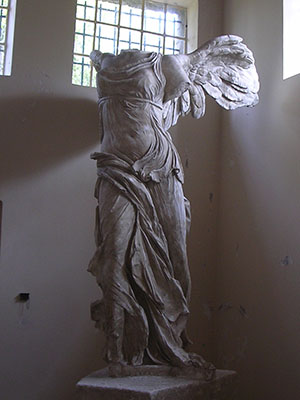|
|
 |
| My Favourite Planet > English > Europe > Greece > Northern Aegean > Samothraki > gallery |
 |
| Samothraki, Greece |
Samothraki gallery |
 |
 |
8 of 46 |
 |
 |
|
 |

Paleopolis Museum Samothraki. A plaster copy
of the famous Winged Victory of Samothrace. |
| |
The statue of the Winged Victory of Samothrace (Νίκη της Σαμοθράκης, Niki tis Samothrakis) depicted Nike, the Greek goddess of Victory, standing or landing on the prow of a warship [1]. The sculpture is thought to have been made by Pythokritos of Rhodes, circa 220-185 BC, as part of a monument to commemorate a victory in a naval battle, and stood above the cavea (audience seating area) of the theatre in the Sanctuary of the Great Gods.

The original statue, now in the Louvre, Paris [2], was made of Parian marble, and the ship's prow and the base (not included with the copy on Samothraki) are of gray marble from Lartos, Rhodes (lithos lartios).

The plaster cast in the Samothraki Archaeological Museum was a gift from the French to the island. There is another copy of the sculpture in the Istanbul Archaeological Museum.

The fragments of the statue were discovered in April 1863 by the French acting vice consul at Adrianople (Edirne, Turkey) and archaeologist Charles-François-Noël Champoiseau (1830-1909), who made exploratory excavations at the site. In the same year he sent the fragments to Paris where they were reassembled and displayed in a prominent position in the Louvre in 1884. Champoiseau returned to the island in 1891 to collect the ship's prow.

The right hand of the figure, discovered in Samothraki in 1950 and identified by the American archaeoligist Dr. Phyllis Williams Lehmann of New York University, is now also in the Louvre. [3]

Another statue of a winged Nike was discovered at the Sanctuary of the Great Gods in 1873 by Austrian archaeologists, and is now in the Kunsthistorisches Museum, Vienna [4]. A third Nike statue, discovered by American archaeologists in 1949, can be seen in the Samothraki Archaeological Museum (see gallery page 9).

This type of statue showing winged Nike landing majestically, with the drapery of her himation (cloak) and peplos (belted by a knotted cord just below the breasts) which cling to the body and legs due to wind and swift movement, can be traced back to the Classical "Nike of Paionios" statue, made in Olympia by Paionios of Mende around 425-420 BC.
See more images of Nike and information about the goddess
on the Nike page of the MFP People section. |
|
photo:
© David John |
|
| |
| Samothraki |
Notes, references and links |
 |
|

1. The ship's prow of the Winged Nike of Samothrace

Further fragments of the ship's prow from the monument have been discovered by American archaeologists between 1939 and 2013.

See: Bonna D. Wescoat (Professor of Art History, Emory University; Director of Excavations, Sanctuary of the Great Gods, Samothrace), Samothrace, Greece. In: Institute of Fine Arts Archaeology Journal, New York. Issue 2, 2013-2014, page 41.

2. Winged Nike of Samothrace in the Louvre, Paris

Winged Nike of Samothrace (French, La Victoire de Samothrace).
Parian marble, circa 220-185 BC.
Discovered in Samothraki in 1863 by Charles-François-Noël Champoiseau (1830-1909).

Musée du Louvre, Paris.
Department of Greek, Etruscan and Roman Antiquities,
Denon, first floor, Daru stairs.
Inv. No. MA 2369.

Height of Nike figure 2.75 metres including wings.
Total height 5.57 m.

The sculpture was extensively restored 2013-2014, and reunited with its base in the form of a ship's prow.

3. Nike's right hand

Marble right Hand of the Nike of Samothrace, found on Samothraki in 1950. "The right hand may have been raised to her mouth in a victory call."

The hand and other fragments of the monument were sent to the Louvre in exchange for two blocks of the frieze of the Hall of Choral Dancers taken to Paris by Champoiseau in 1863 (see gallery page 10).

Louvre, Paris. Inv. No. 2369.
Size: 26 cm.

See a photo of a plaster cast of the hand in the Museum of Classical Archaeology, Cambridge, England:

museum.classics.cam.ac.uk/collections/casts/right-hand-nike-samothrace

4. Winged Nike akroterion in Vienna

Nike statue, akroterion from the Hieron in Samothraki,
Ephesos Museum of the Kunsthistorisches Museum, Vienna.
Inv. No. I 680.

The statue of winged Nike from the Hieron, discovered by the first Austrian archaeological expedition in 1873, led by Alexander Conze (1831-1914).

The photo of statue, right, is from:
Alexander Conze, Alois Hauser, George Niemann, Archaeologische Untersuchungnen auf Samothrake, ausgeführt im Auftrage des K. K. Ministeriums für Kultus und Unterricht. Volume I, Tafel (Plate) XLVIII. Published by Carl Gerold's Sohn, Vienna, 1875. |
|
|
Photos, maps and articles: © David John,
except where otherwise specified.
All photos and articles are copyright protected.
Images and materials by other authors
have been attributed where applicable.
Please do not use these photos or articles without permission.
If you are interested in using any of the photos for your website,
project or publication, please get in contact.
Higher resolution versions are available on request.
Some of the information and photos in this guide to Samothraki
originally appeared in 2004 on davidjohnberlin.de.
My Favourite Planet makes great efforts to provide comprehensive and accurate information across this website. However, we can take no responsibility for inaccuracies or changes made by providers of services mentioned on these pages. |
|
| |
 |
Visit the My Favourite Planet Group on Facebook.

Join the group, write a message or comment,
post photos and videos, start a discussion... |
|
|
 |
|
|
| |
| |
 |
| |
 |
| |
 |
| |
 |
| |

George Alvanos

rooms
in Kavala's historic Panagia District

Anthemiou 35,
Kavala, Greece

kavalarooms.gr
 |
| |
|